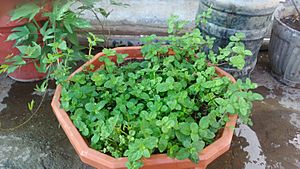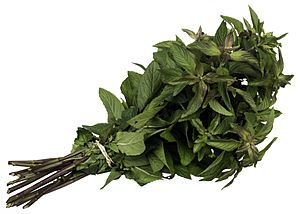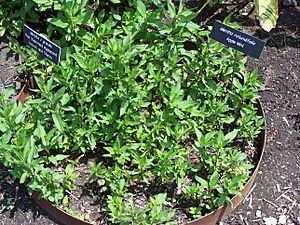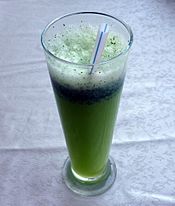Mentha facts for kids
Quick facts for kids Mentha |
|
|---|---|
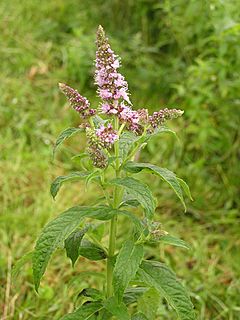 |
|
| Mentha longifolia | |
| Scientific classification | |
| Kingdom: | |
| Division: | |
| Class: | |
| Order: | |
| Family: | |
| Genus: |
Mentha
|
Mentha is a group of plants that you probably know as mint. The word "mint" comes from the Greek word míntha. Mint plants belong to the family called Lamiaceae, which is also known as the mint family.
Scientists believe there are about 13 to 18 different kinds, or species, of mint plants. It can be tricky to tell them apart! Sometimes, different mint species can even mix together naturally to create new types called hybrids. Many other hybrids and special types called cultivars have also been created by people.
You can find mint plants almost everywhere in the world! They grow across Europe, Africa, Asia, Australia, and North America.
Contents
What is a Mint Plant Like?
Mint plants are usually perennial herbs, which means they live for more than two years and have soft stems instead of woody ones. They smell really nice!
Mint plants have parts that spread underground and above ground, called stolons. Their stems grow straight up, are square-shaped, and have branches. The leaves grow in pairs, one across from the other. They can be shaped like an oblong or a lance (like a spear tip). Often, the leaves feel a bit fuzzy and have jagged edges. Mint leaves can be dark green, gray-green, purple, blue, or even pale yellow.
The flowers of mint plants are white to purple. They grow in special clusters called verticillasters. Each flower has four parts, with the top part usually being the biggest. After the flowers, small fruits called nutlets grow, and each one holds one to four seeds.
Where Mint Plants Grow
Mint plants can grow in many different places, but they like wet areas the best. You'll often find them near water, like lakes or rivers, and in moist soil.
Mint plants can grow from 10 to 120 centimeters (about 4 to 47 inches) tall. They can also spread out a lot! Because they spread so easily, some mints are considered invasive. This means they can take over an area if not controlled.
Kinds of Mint Plants
Here are some of the different kinds of mint plants that scientists recognize. Remember, this list can change as scientists learn more! We've also included their common names.
- Mentha aquatica – This is known as water mint or marsh mint.
- Mentha arvensis – Called corn mint, wild mint, Japanese peppermint, field mint, or banana mint.
- Mentha asiatica – Asian mint.
- Mentha australis – Australian mint.
- Mentha canadensis – American wild mint.
- Mentha cervina – Hart's pennyroyal.
- Mentha citrata – Bergamot mint or orange mint.
- Mentha crispata – Wrinkled-leaf mint.
- Mentha dahurica – Dahurian thyme.
- Mentha diemenica – Slender mint.
- Mentha laxiflora – Forest mint.
- Mentha longifolia – Horse mint.
- Mentha pulegium – Pennyroyal.
- Mentha requienii – Corsican mint.
- Mentha sachalinensis – Sachalin mint.
- Mentha satureioides – Native pennyroyal.
- Mentha spicata – This is spearmint or garden mint.
- Mentha suaveolens – Apple mint. Pineapple mint is a special type of apple mint.
- Mentha vagans – Gray mint.
Mint Hybrids
The mint family has many recognized hybrids. These are plants that come from two different mint species mixing together. Here are some examples:
- Mentha × dalmatica (a mix of M. arvensis and M. longifolia)
- Mentha × dumetorum (a mix of M. aquatica and M. longifolia)
- Mentha × gracilis – Also called ginger mint or Scotch spearmint (a mix of M. arvensis and M. spicata).
- Mentha × maximilianea (a mix of M. aquatica and M. suaveolens)
- Mentha × piperita – This is peppermint or chocolate mint (a mix of M. aquatica and M. spicata).
- Mentha × rotundifolia – Also called false apple mint (a mix of M. longifolia and M. suaveolens).
- Mentha × smithiana – Red raripila mint (a mix of M. aquatica, M. arvensis, and M. spicata).
- Mentha × verticillata (a mix of M. aquatica and M. arvensis).
- Mentha × villosa – Also called large apple mint, foxtail mint, hairy mint, woolly mint, Cuban mint, mojito mint, and yerba buena in Cuba (a mix of M. spicata and M. suaveolens).
- Mentha × villosonervata – Sharp-toothed mint (a mix of M. longifolia and M. spicata).
Growing Mint Plants
Most mint plants grow best near water, like ponds or rivers, and in cool, damp spots with some shade. However, mints are quite tough and can also grow well in full sun. Mint plants grow all year round!
They grow very quickly, spreading out along the ground using their runners. Because they grow so fast, just one mint plant, with a little care, can give you plenty of mint for your home. Some mint types spread more than others. Even with the less spreading kinds, you should be careful when planting mint near other plants, as it might take over. To keep mint from spreading too much in a garden, you can plant it in deep pots without bottoms, sunk into the ground. Or, you can grow it above ground in tubs and barrels.
You can grow some mints from seeds, but this isn't always the best way. Mint seeds can be very different from each other, so you might not get the plant you expected. Also, some mint types don't produce seeds that can grow. It's usually better to take small pieces (cuttings) from healthy mint runners and plant those.
The most popular mints grown for selling are peppermint (Mentha × piperita), native spearmint (Mentha spicata), Scotch spearmint (Mentha x gracilis), and cornmint (Mentha arvensis). More recently, apple mint (Mentha suaveolens) has also become popular.
Mints are thought to be good companion plants. They can help keep away annoying insects and attract helpful ones. However, mints can sometimes get whitefly and aphids.
You can pick mint leaves any time. Fresh leaves are best used right away or stored in plastic bags in the refrigerator for a few days. You can also freeze leaves in ice cube trays. Dried mint leaves should be kept in a sealed container in a cool, dark, dry place.
How We Use Mint
Mint in Cooking
The leaves of the mint plant, whether fresh or dried, are used in cooking. Fresh mint is usually preferred if you can use it right away. Mint leaves have a warm, fresh, sweet smell and taste, with a cool feeling afterward. They are used in teas, drinks, jellies, syrups, candies, and ice creams.
In Middle Eastern cuisine, mint is often used with lamb dishes. In British cuisine and American cuisine, you might find mint sauce and mint jelly.
Mint is a key ingredient in Touareg tea, which is a popular drink in North African and Arab countries. Alcoholic drinks sometimes use mint for flavor or as a decoration, like in a mint julep or a mojito. Crème de menthe is a mint-flavored liqueur used in drinks like the grasshopper.
Mint essential oil and menthol are widely used to flavor things like breath fresheners, drinks, antiseptic mouth rinses, toothpaste, chewing gum, desserts, and candies, such as mint (candy) and mint chocolate. The main things that give mints their special smells and tastes are menthol (found in peppermint) and pulegone (found in pennyroyal and Corsican mint). The main flavor in spearmint is from a compound called L-carvone.
Some Lepidoptera (moths and butterflies) larvae, like the buff ermine moth, eat mint plants.
Mint in Medicine and Beauty Products
Mint was first used as a medicinal herb to help with stomach aches and chest pains. It is still used in traditional medicine, and some early studies suggest it might help with irritable bowel syndrome.
Menthol, which comes from mint essential oil (40–90%), is used in many cosmetics and some perfumes. Menthol and mint essential oil are also used in aromatherapy, which might help reduce nausea after surgery.
Allergic Reactions to Mint
Even though mint is in many products we use every day, some people can have allergic reactions to it. This can cause symptoms like stomach cramps, diarrhea, headaches, heartburn, a tingling or numb feeling around the mouth, or even a serious reaction called anaphylaxis. Some people might also get a skin rash called contact dermatitis.
Mint as an Insect Repellent
Mint oil can also be used as an environmentally friendly insecticide. It can kill some common pests like wasps, hornets, ants, and cockroaches.
Mint for Room Scent and Aromatherapy
In ancient Greek stories, mint was known as the herb of hospitality. One of its first uses in Europe was to make rooms smell better. People would spread mint herbs on their floors to cover up bad smells from the dirt. When they walked on the mint, it would release its scent into the room. Today, mint essential oils are often used for aromatherapy to create a pleasant smell and help people relax.
Images for kids
See also
 In Spanish: Menta para niños
In Spanish: Menta para niños


